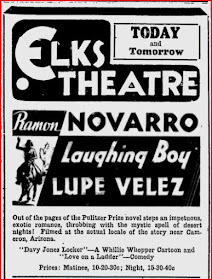Of Metro-Goldwyn-Mayer's silent leading men inexorably struck down after the coming of sound, Ramon Novarro held out the longest. Despite a Mexican accent that didn't disqualify him from "Latin lover" status, Novarro found a singing voice that promised him a musical future. When that didn't pan out, he became an all-purpose ethnic, playing Europeans, Hindus, Chinese and Arabs. Finally, if not inevitably, he played a Navajo Indian in his penultimate M-G-M film. Laughing Boy was a prestige picture of a sort, adapted from Oliver LaFarge's Pulitzer-winning novel and entrusted to Metro's ethnographic entertainment expert, W.S. Van Dyke. But Novarro looks wrong for the part, wearing a heavy layer of makeup as if still in a silent movie and more pale than the other Native American characters. He doesn't quite sound right, either, saddled like compatriot co-star Lupe Velez with dialogue punctuated with that stock clause of the pulp Mexican, "I theenk." For 1934 Metro remembered Novarro's musical talent; his other picture of the year was a big part-Technicolor operetta, The Cat and the Fiddle, and in the actual novel Laughing Boy is described often singing to his gods. But Novarro's singing sounds more like what he was up to back in The Pagan than any Native song I've heard. His overall performance isn't really bad, but he ends up upstaged by possibly career-best work from Velez, liberated from her usual "spitfire" shtick, as the hero's more complex and conflicted love interest.
Laughing Boy is meant as a sympathetic portrait of Native Americans in a white-dominated world, and the film gives us a wider range of Indian personalities than most films of the period. In an implicit commentary on Natives' fractured identity, both hero and heroine have multiple names. Neither is known by their birth name, and Slim Girl (Velez) calls herself Lily in the big city, while our hero is not only "Laughing Boy" -- an ironic naming, perhaps, since the movie character isn't much of a jokester -- but also "Grandfather" in a more obvious comment from fellow Navajo on his traditional ways, and "Wrestler," for the prowess that lets him win a double-or-nothing bet after losing his horse in a race. He falls in love with Slim Girl despite his initial aversion to her American-influenced ways, e.g. dancing too close. A mutual ambivalence persists past marriage, as Slim Girl is torn between the attractions of city life, where she is often a kept woman, and a desire for more rooted existence, even though her American education has unfitted her for the rigors or reservation life. Slim Girl will automatically get the modern audience's sympathy, if she didn't already have the 1934 audience's sympathy, because of her profound alienation from both worlds. People will most likely be on her side from the scene back in the city where she tosses candy over a fence to treat the next generation of Natives going through the American educational mill and gets into a screaming match with her old repressive teacher. Yet her life with Laughing Boy's people is just as demoralizing. Our hero may be a nice guy, but he comes with the west's worst in-laws, utterly unfiltered in their disdain for anything American and modern, including Slim Girl. She tries her best and actually weaves a decent rug without realizing it, only to be told that her design is unfeminine somehow. But she finally draws the line at slaughtering goats for dinner; once she hears the animal bleat she can't go through with it, making herself hopeless in the in-laws' eyes. There's nothing Laughing Boy can do about it; he's condemned in turn for furnishing his hogan with such modern conveniences as a chair, a bed and a phonograph and is accused of being too ambitious a sheepman for his own good.
Something obviously has to give once Slim Girl moves back to the city to make money by selling Laughing Boy's silver crafts and hooking up again with an old American boyfriend. The marriage begins to look like the sort of role-reversal we've seen in other Depression films where the wife becomes the breadwinner, and even though Laughing Boy appears to be successful in his own right, at least in material terms, the old suspicion of the wife in the workplace rears its head. Unexpected, Laughing Boy shows up in the city to eat popcorn and check on his woman. Finding her with the American, he goes instantly into kill mode, though his target is the American rather than his offending spouse. I found it odd that our hero went for his bow and arrow instead of a knife, but I guess the tragic choreography demanded this, since the maneuver gives the cowardly American time to use Slim Girl as a human shield. The white man gets away, of course, while husband and wife make their apologetic farewells. The film closes with Novarro performing an aria of mourning after burying Slim Girl on his land, giving her a home at last. The ending is inescapably sappy and word of mouth may have contributed to the film flopping and most likely sealing Novarro's fate with Metro. But Lupe Velez's performance and an unusually complex portrait of Native American life make Laughing Boy worth a look regardless of its consequences for its star's career.

No comments:
Post a Comment